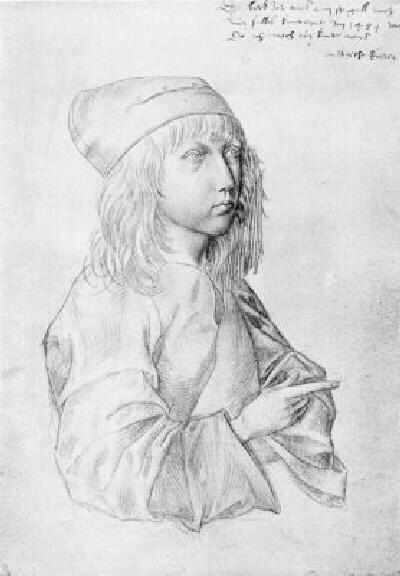
Artists Illustrating German Boys' Fashions: Albrecht Dürer (Germany, 1471-1528)

Figure 1.--This is Dürer's first knon work. It is a self portrait done in 1584 when he was 12-13 years old. It is a remakable image considering his age and lack of formal training. It also provides us a fascinating glimse of how boys from an artisam family dressed and wore their hair at the time. He was about to begin his aprenticeship.
|
|
Albrecht Dürer was born at Nuremberg in 1471. He was first a goldsmith, travelled around the country and to Italy. He married Agnes Frey. They had no children. He is regarded as one of the famous painters between Middle Ages and the Renaissance. He accepted Luther's teaching and is considered to be the first important Protestant painter. He is noted most for religious works, but he also did landscape and portraits as well of studies about proportions of the human body. Perhaps his most famous drawing is "Praying hands". He did a self portrait of himself as a youth. He did it while looking into the mirror at the age of 13 or 14. Notice the interesting clothing!
Parents
Albrecht's father was Hungarian. He came to Nürenberg in 1455 to practice his trade as a goldsmith.
Childhood
Albrecht was born in 1471 in the Imperial Free City of Nürenberg. He was the third son of the Hungarian goldsmith Albrecht Dürer.
Chronology
Dürer lived at a momentous time in European history. His life spanned the 15th and 16th centuries. When he was born, German was still medieval. He was one of the figures that led Germany into the Renaisance and modernity. During his life soan the European outreach and the discovery of the America occurred. In Europe this was followed by Luther's Protestanr Reformation. He was a contemprary of Ldeonardo.
Education
Training
Albrecht became an apprentice in his father's goldship shop in 1485 when he was about 13 years old. Albrecht had much wider interests than goldsmithing. He had already begun to draw and paint. Notice his self-portrait here (figure 1). His father approved an apprenteceship with Michael Wolgumut, a painter and printmaker. It was here that he learned his engraving skills.
Travels
As with many Renaissance artists, especially the non-Italians, travel was a key element of their artistic development. Albrecht began his travels in 1490 when he was about 19 years old. He continued his travels even as his reputation grew. He traved to Italy in 1494 to study the work of the great Italian Renaissance masters. He traveled to Antwerp in 1505-07 and to other areas in the Low Coubtries during 1520-21. Durer was especially impressed with the work of Giovanni Bellini and Bellini's brother-in-law Andrea Mantegna.
Career
Albrech even before his appreteships was drawing and painting. After being appreticed to Wolgumut, he also began working with woodcuts and copper engravings. Dürer was generally considered the greatest German artist of the Renaissance. He was a printmaker, draughtsman, and art theorist. Dürer in 1496-98 published a portfolio of woodcuts, "The Apocalypse of St. John". Some art historians believed that it was a reflection of his commitment to the Protestant cause and that Babylon was used to indite Rome. Dürer's paintings were both religious works and portraits. He is know to have been painting portraits as least as early as 1512. He pointed portraits for both nobels and wealthy merchants. He painted the Emperor Maximilian I (about 1518) and Christian II of Denmark (1521). Other sitters included various merchants, clergymen, and government officials. He also did several self-portraits and various ages.
Dürer was a prolific artist. He is noted most for religious works, but he also did landscape and portraits as well of studies about proportions of the human body. He also worked on animals. His left an enorous body of work which includes altarpieces and other religious works, and numerous portraits and self-portraits. He did both copper engravings and woodcuts. Interestesingly, many of his woodcuts, like the
Apocalypse series (1498), have a Medieval Gothic look while his copper engravings seem more in tune with the Renissance. His earliest known work is a self portrait he made in 1584 when he was 12-13 years old. Art historians believe that his masterpices were the copper engravings "the Knight", "St. Jerome in His Study", and "Melencolia I" done in 1513-14. While Dürer is perhaps best known for his prints, he was also an important painter. Perhaps his most famous drawing is "Praying hands" as it has been reproduced in so many religious publications and hung in so many Church buildings. Another important religious work was "Christ among the doctors" about the youthful Jesus.
Assessment
Most consider him the first real German artist. He rejected the classical standards of Gothic art. He accepted Luther's teaching and is considered to be the first important Protestant painter. He is also credited with fusing the German Gothic tradition with that of Renaissance Italy, especially the adoption of perspective and plasticity of movement. Dürer compiled his artistic theories in Four Books on Human Proportions which was published posthumously in 1528.
Family
He married Agnes Frey. They had no children.
Later Years
Dürer died in Nürenberg where he was born in 1528.
HBC

Navigate the Boys' Historical Clothing Web Site:
[Return to the Main German page]
[Return to the Main Renaissance page]
[Introduction]
[Activities]
[Biographies]
[Chronology]
[Clothing styles]
[Countries]
[Bibliographies]
[Contributions]
[FAQs]
[Glossaries]
[Images]
[Links]
[Registration]
[Tools]
[Boys' Clothing Home]
Navigate the HBC Art pages:
[Return to the Main German national art page]
[Return to the Main individual A-F artist alphabetical page]
[Chronology]
[Country]
[Individuals]
[Styles]
Created: August 11, 2003
Last updated: 12:37 AM 7/6/2008



